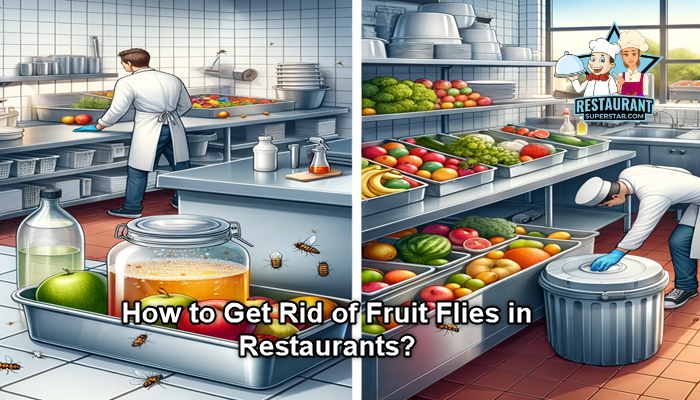How Does a Restaurant Grease Trap Work?
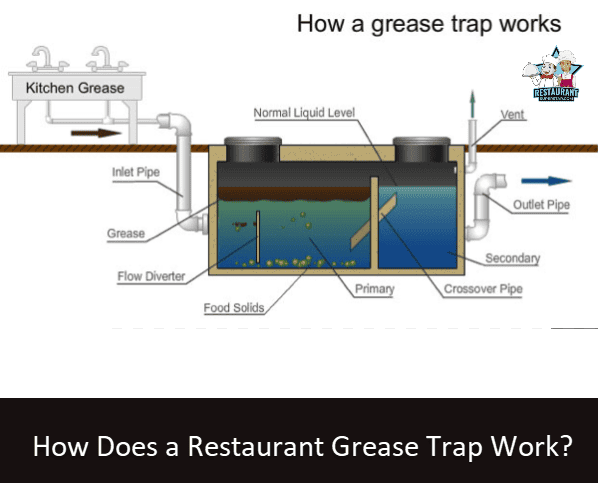
If you’ve ever asked yourself, “How does a grease trap work in a restaurant?” you’ve landed in the perfect spot.
This article has got you covered, answering this vital question and diving into many other intriguing facets that revolve around grease traps.
Being a restaurant owner or chef, you’re already juggling multiple balls; don’t let a grease trap be one of those mysteries.
So, stick around because things are about to get much more enjoyable.
How Does a Restaurant Grease Trap Work?
How Does a Restaurant Grease Trap Work? A grease trap functions as a guardian for your restaurant’s drainage system. Using basic science we all learned in school, it separates the fats, oils, and grease (known as FOG) from the wastewater, preventing them from clogging the drains. As the wastewater flows through, the less dense FOG rises to the surface, getting trapped. At the same time, the heavier solids sink, and the relatively cleaner water remains in the middle.
But wait, there’s so much more to it.
Did you know there are automatic and manual versions? Or that how you maintain them can make or break their efficiency?
Dive deeper into this article, and we’ll unravel all these mysteries, offering you a comprehensive guide on everything you need to know about how a grease trap works in a restaurant.
From consulting for various eateries around sunny Florida, I’ve gathered a wealth of insights and personal anecdotes that will keep you glued to every word.
So, are you ready to dive deep into grease traps?
Trust me; it’s more captivating than it sounds.
Understanding the Intricacies of Grease Traps
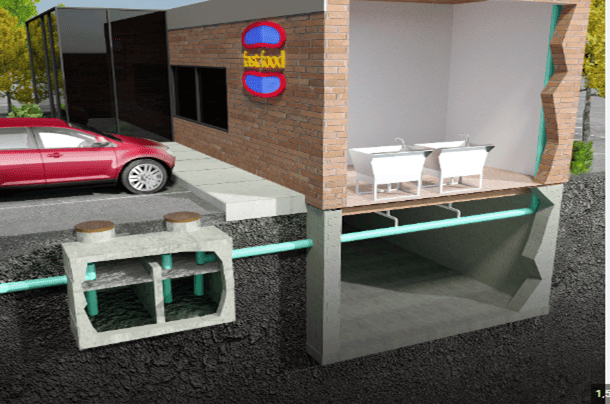
Understanding the intricacies of grease traps is not just about avoiding plumbing mishaps (though that’s a big part); it’s about ensuring your restaurant runs seamlessly.
Over my years consulting for restaurants, from the cozy diners of Jacksonville to the bustling eateries of Miami, I’ve observed a trend: those who get a handle on their grease management fare way better in the long run.
You see, as restaurant owners, we’re in the business of serving up deliciousness. But a lot goes on behind the scenes to ensure that happens smoothly, and grease traps are a critical part of that equation.
It’s like the unsung hero of a restaurant’s plumbing system, ensuring your kitchen keeps humming and your diners return for more.
Throughout my journey, I’ve met numerous restaurant owners, chefs, and managers who’ve faced challenges, primarily because they overlooked this seemingly small yet crucial component.
But worry not; that’s precisely why I’m here.
Drawing from my personal experiences and interactions, I’ll walk you through the ins and outs of grease traps, providing insights that will answer your burning questions and help you master the art of grease management.
So, grab coffee (or iced tea if you’re genuinely Floridian like me), and let’s dive in.
The Role of Restaurants in FOG Waste Management
Florida is a state of wonders. From picturesque beaches to vibrant nightlife, it has it all.
Yet, amidst our delightful experiences, we bear significant responsibilities, particularly in the waste, which stands for fats, oils, and grease, which rests heavily on our shoulders.
The stakes are far greater than they may initially seem. And let’s not forget, when it comes to key lime pie, Florida reigns with the tastiest slice you’ll ever devour.
I’ve noticed a common thread while hopping between eateries and cafes across Florida. Many restaurant owners need to be fully aware of the ripple effect improper FOG disposal can create.
Let’s break it down:
- Environmental Impact: The beauty of our state is in its natural wonders. Dumping grease down the drain doesn’t just clog up pipes; it disrupts ecosystems and harms marine life. Over time, this untreated FOG waste can enter our oceans, endangering our precious Florida wildlife. As restaurateurs, the onus is on us to protect our home.
- Sewer Struggles: I can’t count the number of times I’ve seen local establishments battle backed-up sewers, all because of mismanaged FOG. Worse, these blockages can affect entire communities, leading to overflow issues that could be more pleasant to deal with and live around.
- Hefty Consequences: If the environmental reasons aren’t convincing enough, here’s a hard truth: mishandling FOG waste can hit you where it hurts the most – your wallet. Local water companies have their eyes peeled for restaurants that contribute excessively to FOG waste. Get flagged, and you’re looking at severe fines, frequent inspections, and a reputation that could deter even your most loyal customers. Remember, news travels fast in Florida, and nothing spreads quicker than a story about a beloved eatery falling afoul of environmental regulations.
In my consulting days, I’ve been the bearer of bad news more times than I’d like. Informing a passionate restaurant owner that they’re on the radar for FOG mishandling is heart-wrenching, especially when they’ve poured their soul into their establishment.
The bright side?
It’s entirely preventable. By understanding and implementing proper FOG waste management, you safeguard your restaurant’s reputation, wallet, and the beautiful state we all love.
So, next time you’re frying up some grouper or pouring out that leftover oil, take a moment to think about where it’s going.
Our actions in the kitchen ripple out further than we might realize, and with a bit of attention to detail, we can make sure those ripples are positive.
What is a Grease Trap in a Restaurant?
What is a Grease Trap in a Restaurant? It’s a device designed to capture fats, oils, and grease (our now infamous FOG) from wastewater before it gets into the sewer system. Picture this: when you wash dishes or clean your kitchen appliances, the water often contains leftover grease from cooking. This water flows down the drain, and without a grease trap, it would carry all that grease straight into the sewer, leading to those nasty blockages we discussed earlier.
Now, I have to share a little story because my first interaction with a grease trap is one I’ll never forget. Years ago, fresh out of culinary school and just starting my consulting journey, I was helping a small diner in Orlando.
Their food? Heavenly.
Their plumbing? A complete nightmare.
They called me over, perplexed by the frequent clogs they were facing. And there it was, tucked away in a corner of their kitchen, an ancient grease trap that looked like it had seen better days during the disco era.
The owner, bless her heart, had no idea what it was, let alone how to maintain it. It was a learning experience for both of us.
While she discovered the critical role of grease traps, I realized just how widespread the lack of knowledge about them was.
For restaurants, especially in our great state of Florida, where environmental regulations are tight and community scrutiny is real, having a functioning grease trap isn’t just recommended; it’s paramount.
Not only does it help prevent plumbing mishaps, but it also ensures you’re playing your part in protecting our environment.
And remember, it’s not just about having one; it’s about maintaining it, ensuring it’s doing its job correctly, and keeping those FOGs from causing chaos.
The Science Behind Grease Traps
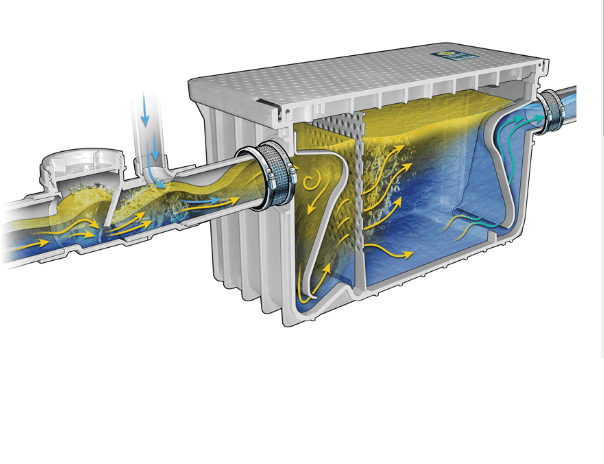
Alright, folks, let’s put our science caps on for a moment. Don’t worry; this will differ from your high school chemistry class.
Instead, let’s dive into something we’ve all observed in our kitchens but maybe need to understand fully: why don’t oil and water mix? And how does this relate to the magic of grease traps?
First up is the age-old observation. Pour some oil into a glass of water, give it a gentle stir, and watch the spectacle.
The oil will always float up, separating from the water. Why? Well, it’s all about density. Whether animal fats or vegetable oils, oils are less dense than water.
So, they tend to rise above it, refusing to mix.
This principle is at the heart of how a grease trap works. Now, picture this: when wastewater filled with fats, oils, and grease flows into the trap, it enters a chamber where the water flow slows down significantly.
This slower pace allows the water and its unwelcome oily guests to separate, thanks to our old friend, density.
In this slowed-down state, the wastewater in the grease trap divides into three distinct layers:
- Solids: These are the heavier particles that settle at the very bottom of the trap.
- Wastewater: This forms the middle layer, acting like a buffer zone. It’s mostly free of contaminants and can flow into the sewer system.
- FOG (Fats, Oils, and Grease): Remember our density chat? These lightweight culprits rise to the top, forming a layer safely kept away from the main sewer system.
I recall a moment during a consultation in Miami when a genuinely curious chef asked me how grease traps work. When I explained this simple science to him, his face lit up with understanding.
He responded, “So, it’s like making a salad dressing, but in reverse!” And you know what? He was right.
In the world of grease traps, we’re letting the ‘dressing’ separate intentionally to keep our systems running smoothly.
So, there you have it – a little science, a dash of observation, and a sprinkle of common sense. And just like that, you’ve unlocked the mystery of grease traps.
Manual vs. Automatic Grease Traps
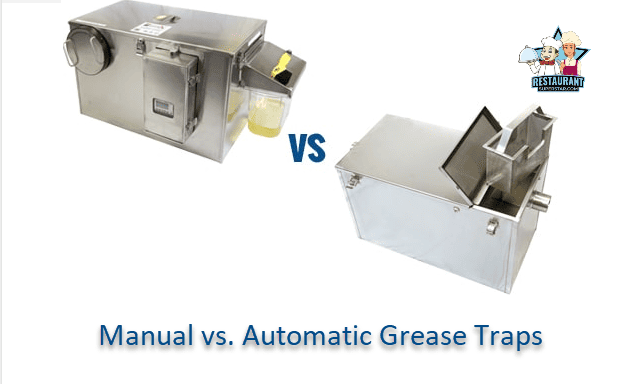
Like in many other industries where technology marches on, in the world of grease management, we’ve got a choice between the traditional, manual grease traps and the newer, high-tech Automatic Grease Removal Units, or AGRUs.
So, what’s the difference, and which one should you pick? Buckle up; we’re diving in.
The Time-Tested Manual Grease Traps
Manual grease traps have been the loyal guardians of our plumbing for over a century. They’re the old workhorses.
Typically constructed from stainless steel or durable plastic, these traps function. The slowed wastewater enters, the layers separate, and the FOGs are captured.
But here’s the catch – manual means manual. These traps must be emptied and cleaned by hand or, more realistically, by a professional.
Remember, consistency is vital. You’ll need to schedule regular cleanings, usually every 2-4 weeks, depending on the trap’s size and your restaurant’s volume.
In my early days, I worked with a seafood joint in Tampa that swore by their old-school manual trap. It was like a ritual for them.
The cleaning crew came in every third Sunday, and the grease trap got its spa day. And it worked! That trap served them faithfully for years.
The Sleek and Efficient AGRUs
Enter the age of automation. AGRUs, or Automatic Grease Removal Units, are the newer kids on the block.
They’re designed to do precisely what manual traps do, with a bonus: they automatically remove the collected FOG at predetermined intervals.
There is no need for that third Sunday ritual.
The advantages? A more hands-off approach.
The AGRUs can empty the trapped FOG into a separate container daily or as programmed, making it ready for collection.
This automation reduces the chances of overflow, decreases potential odors, and offers a generally cleaner, more efficient experience.
I consulted for a high-volume burger place in Jacksonville a few years back. They switched from a manual system to an AGRU; the difference was night and day.
They reduced their maintenance calls, and the kitchen staff appreciated the reduced odor and fewer pest concerns.
My Two Cents
Now, for my take. Both systems have their merits. The traditionalist in me admires the longevity and simplicity of manual traps.
But the consultant, always looking for efficiency and innovation, leans towards AGRUs for higher volume restaurants or those wanting a more streamlined process.
Ultimately, the choice hinges on your restaurant’s specific needs, volume, and the kind of maintenance schedule you’re comfortable with.
My advice?
Carefully evaluate the advantages and disadvantages, taking into account the unique dynamics of your restaurant, to make a well-informed decision.
Maintenance Matters: Ensuring Efficiency
Maintenance. The word might not be glamorous, but let me tell you, it’s the backbone of a smooth-running restaurant, especially regarding grease traps.
Over my years of consulting in sunny Florida, I’ve realized that regardless of the grease trap system you opt for, its efficiency and longevity hinge mainly on how well you maintain it.
The Critical Role of Regular Cleaning
Imagine this: You’ve got a shiny new car, the kind you’ve always dreamed of. But you always keep the oil the same, check the tires, or even wash it.
How long do you think that car’s going to run smoothly?
Not long, right?
The same principle applies to grease traps.
These devices, as hardworking as they are, accumulate solids and FOG over time. And if left unchecked, this buildup can cause backups, odors, and decreased efficiency.
Regular cleaning ensures your grease trap runs at its best, preventing unforeseen and costly issues.
Professional Cleaning vs. Daily Emptying: Which is Better?
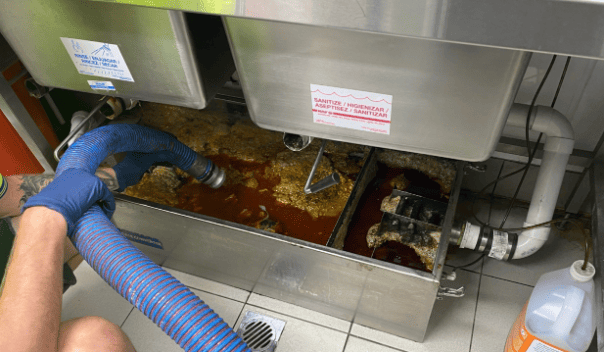
There needs to be more clarity here, which I’ve noticed among many restaurant owners. Some think that if they have an AGRU that empties daily, they don’t need to call in the pros for a thorough clean.
Well, that’s a misconception. While daily emptying, especially with AGRUs, is fantastic for managing FOG levels, it only partially negates the need for professional cleaning.
Think of it as brushing your teeth daily but still needing to visit the dentist for a deep clean. You’re doing daily maintenance, but occasionally, you need a pro to get into the nitty-gritty.
In my experience, a restaurant in Miami once believed they could skip the professional cleaning since they emptied their AGRU daily. Fast forward a few months, and they faced a hefty bill for system repairs.
The lesson? Make sure to do professional cleaning, folks.
The Unspoken Dangers: Insects and Vermin Attraction
Alright, it’s time to address the elephant in the room. Or the roaches and rats?
If you need to maintain and clean your grease trap, you roll out the red carpet for unwanted guests.
Old, accumulated grease is like a five-star buffet for pests. The last thing any restaurant owner wants is a pest issue, especially in Florida, where these critters thrive.
Beyond the financial and operational implications, there’s a reputational risk, too.
In the age of online reviews, one sighting of a pest can damage your restaurant’s reputation. Trust me, rebuilding trust is a lot harder than regular maintenance.
In the restaurant business, being proactive rather than reactive always pays off.
Regular grease trap maintenance isn’t just a chore; it’s an investment in the longevity and reputation of your establishment.
So, make it a point to maintain regularly, clean professionally, and keep those pesky pests at bay.
The Added Advantage of Strainers
Strainers, the often forgotten heroes of the culinary realm. During my early days of consulting for various restaurants in Florida, I was pretty surprised by the number of establishments that underestimated the significance of this straightforward yet remarkably efficient utensil.
But let’s dive in and see why every restaurant, from the quaint little cafes in Tampa to the bustling diners in Orlando, should be singing praises for strainers.
Role of Strainers in Grease Traps
Simply put, think of filters as the gatekeepers of your grease trap. They catch the chunky bits and pieces, ensuring only liquids find their way down.
This not only aids in increasing the efficiency of the grease trap but also significantly extends its life.
The more solids a filter can catch, the less sediment builds up at the bottom of the grease trap, which means fewer cleanings and lower maintenance costs in the long run. It’s a win-win.
You might think, “Jeff, I’ve got a grease trap. Do I need a filter?” And to that, think of your grease trap as a star quarterback.
He’s essential to the game, but he will get sacked without a solid offensive line (that’s your filter!) protecting him. The same principle applies here.
Importance of Sink Food Waste Strainers
While we’re on the topic, let’s remember to sink food waste strainers. These little meshed wonders are like the first line of defense against food particles.
Positioned right at the source – the sink – they catch food waste, ensuring that your drains remain clog-free and that larger chunks don’t make their way to your grease trap.
During one of my visits to a popular seafood joint in Key West, the chef was lamenting about frequent drain clogs. When I looked, I realized they didn’t have sink filters.
Once installed, not only did the clogging issues diminish, but their grease trap maintenance cycle also extended. It was a slight change with a significant impact.
Strainers for grease traps and sinks might seem like insignificant additions. But in restaurant operations, where every detail counts, they’re indispensable.
If you’re not already using them, it’s time to consider their benefits. After all, in the culinary world, it’s often the little things that make the most significant difference.
Bio-dosing: The Future of FOG Management?
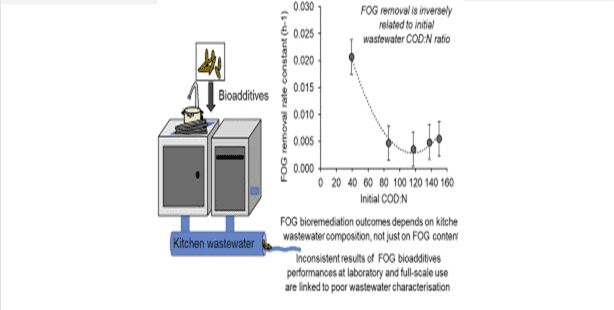
Suppose you’ve been in the restaurant business long enough or are just starting in Florida’s vibrant culinary scene. In that case, you’ve heard whispers about bioremediation.
Doesn’t it feel like one of those captivating terms extracted directly from the enchanting pages of a science fiction masterpiece?
But let me assure you, it’s far more science than fiction, and it’s revolutionizing how we handle FOG in our restaurants.
Introduction to Bioremediation and Its Effectiveness
Let’s break it down. Bioremediation uses living organisms, typically microbes, to break down unwanted substances – in this case, fats, oils, and grease.
Instead of trapping and storing the FOG, these little microbial heroes digest it, turning it into harmless byproducts.
The effectiveness?
Well, it’s pretty impressive. The process is natural, reduces the need for chemical treatments, and, when done right, can dramatically reduce the amount of FOG in our wastewater systems.
This means fewer cleanings, fewer clogs, and a more sustainable approach to managing kitchen waste.
My View on Bioremediation’s Role in the Florida Restaurant Scene
As someone who’s been advising restaurants from Miami to Jacksonville, I’ve seen firsthand the shift toward more sustainable practices.
Florida has always had a special place in my heart with its beautiful beaches and unique ecosystems.
And I’m thrilled to see restaurant owners becoming more environmentally conscious.
More and more establishments are considering bioremediation and for good reasons.
It is an effective way to manage FOG. It showcases a restaurant’s commitment to sustainability – something that diners in the Sunshine State sincerely appreciate.
I recall advising a restaurant in St. Petersburg a couple of years back. They needed help with frequent grease trap cleanings and were looking for alternatives.
When I suggested they look into bioremediation systems, they were initially skeptical.
But a year into using it, they were floored by the results – reduced maintenance costs and a notable decrease in FOG-related issues.
Plus, their customers loved the fact that they were adopting greener practices.
So, is bio-dosing the future of FOG management in Florida’s restaurants? While I won’t claim it’s the one-size-fits-all solution, it’s undoubtedly a powerful tool in our arsenal.
It aligns with the global shift towards sustainability and offers practical benefits that are hard to ignore.
If you haven’t already, consider giving bioremediation a severe thought. The future, after all, is green.
Legislation and Grease Traps

As a restaurant consultant here in Florida, one of the frequent topics in my discussions with restaurant owners is the law.
We wish those regulations and rules were more straightforward, but we can’t ignore them.
Regarding FOG, there’s some specific legislation that every restaurant owner should know. Let me break it down for you.
Highlighting The Building Regulations Related to Grease Management
First and foremost, let’s talk about The Building Regulations, specifically document H, section 2.21. What it states is relatively straightforward but vital for those in the restaurant business.
Suppose you have a commercial food establishment that serves hot food connected to the main drainage system. In that case, you must have some grease management in place.
This could be a grease separator or another effective means of removing grease.
Why the emphasis on this?
It’s all about ensuring that our drainage systems aren’t clogged up with fats, oils, grease, and starches (FOG) that can lead to environmental damage and costly repairs.
Clarifying Who Needs a Grease Trap
You might be thinking, “Does this apply to me?” Here’s the low-down: You likely need a grease management system if you run a commercial kitchen – a cozy diner in Tampa or a bustling beachside restaurant in Miami. It doesn’t matter if your place is small or large.
The critical factor is that you’re in the game if you’re preparing and serving hot food and connected to the mains.
I’ve noticed a few misconceptions from my experience roaming around Florida’s restaurant scene.
Some believe they don’t need a grease trap because they run a smaller establishment or only fry a little food.
Unfortunately, that’s not how it works. Nearly every restaurant produces FOG in some capacity, and the regulations are in place for a reason.
Florida’s a rich culinary scene, and I’m proud to be a part of it. As restaurant owners, ensuring compliance isn’t just about avoiding penalties or fines. It’s about playing our part in maintaining our beautiful state and ensuring our businesses operate smoothly.
Investing time comprehending and adhering to grease trap regulations will spare you considerable future distress.
Picking the Right Grease Management Solution
If there’s one thing I’ve learned from years of consulting with restaurants in the Sunshine State, it’s this: Not all grease management solutions are created equal.
I’ve seen my fair share of establishments in Florida facing issues just because they opted for a one-size-fits-all approach.
That’s why picking the right equipment tailored to your restaurant’s needs is paramount.
Importance of Choosing the Right Equipment
Selecting the right grease trap isn’t just about ticking off a box in the compliance checklist. It’s about efficiency, cost savings, and peace of mind.
Every restaurant has its unique operations. Some might have a fry-heavy menu; others might deal with many vegetable oils.
Your grease trap needs will differ depending on the volume and type of FOG waste you produce.
Moreover, there’s also the size and layout of your kitchen to consider. Some solutions fit seamlessly, while others might be more intrusive or harder to maintain due to space constraints.
And if there’s one thing we all can agree on, no one wants an unwieldy piece of equipment getting in the way during a dinner rush!
The Impact on Restaurant Operations, Compliance, and the Bottom Line
Let’s talk brass tacks. A poorly chosen grease trap can lead to frequent clogs or malfunctions.
Not only can these disruptions put a damper on your operations, but they can also lead to non-compliance, resulting in fines or even temporary shutdowns.
And, of course, frequent maintenance or replacements can start to eat into your profits.
On the flip side, a well-chosen grease trap?
It’ll run smoothly, ensuring you stay compliant and avoid unforeseen costs.
It’s an investment, sure, but it pays dividends in the long run.
My Recommendations Based on Consulting Experience
From the numerous restaurants I’ve consulted for, here’s my two cents:
- Assess Your Needs: Before diving in, understand the volume and waste your restaurant produces. A quick chat with your kitchen staff can provide invaluable insights.
- Space is Key: Ensure that the system you’re considering fits well within your kitchen’s layout. Remember, accessibility is crucial for maintenance.
- Seek Expert Advice: Seek the expertise of an expert can prove invaluable. A fresh perspective can unearth potential issues or propose more efficient solutions. Don’t hesitate to invite their insights and leverage their expertise.
- Think Long-Term: Considering long-term benefits and ease of maintenance, it’s worth reflecting on upfront costs. At times, investing a bit more initially can lead to substantial savings in the future.
- Stay Updated: Grease trap technology is continually evolving. Stay informed about new advancements or solutions that might benefit your operations.
Your grease management solution is the unsung hero of your kitchen. Give it the thought and attention it deserves, and it’ll serve you (and your dishes) well for years.
How Do You Maintain a Restaurant Grease Trap?
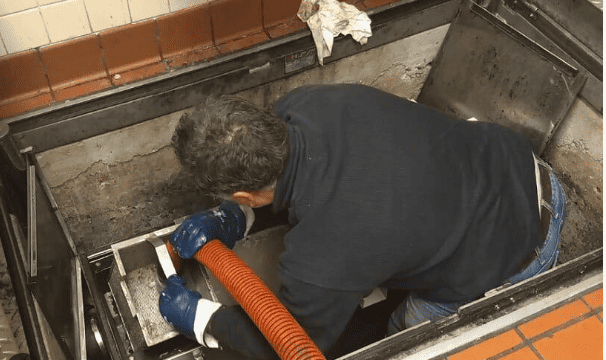
Maintenance, huh?
It’s not exactly the word that gets restaurant owners all excited, but let me tell you, when it comes to grease traps, it’s the secret sauce for keeping everything running smoothly.
I’ve been in countless Florida kitchens, from Miami to Jacksonville, and you wouldn’t believe how often even the best restaurants stumble by neglecting their grease trap maintenance.
Let’s dive right in and chat about how to keep things running like a charm.
Emphasizing the Importance of Professional Maintenance
First, I want to stress something: Don’t try to DIY your grease trap maintenance for the love of everything crispy and fried.
This is different from unclogging a home drain. Grease traps deal with a hefty amount of fats, oils, and grease, and attempting to tackle it alone can lead to more significant issues.
Always, and I mean always, get professionals to handle it.
Professional maintenance ensures that all the FOG is correctly removed, the trap is cleaned thoroughly, and all parts are in good working order. It’s not just about cleanliness; it’s about ensuring efficiency and longevity.
Crafting a Maintenance Schedule: Size, Flow, and Usage Considerations
The golden question: “How often should I get my grease trap serviced?” Well, the answer is a complex one. It boils down to a few key factors:
- Size of Your Grease Trap: Smaller traps might fill up quicker and thus require more frequent servicing. On the other hand, larger systems might have longer intervals but need a more thorough clean-up when the time comes.
- Flow & Volume: Busy restaurant with a ton of fried dishes? You’re likely producing more waste, which means more frequent servicing.
- Usage Patterns: If you have seasonal surges, like a boost in diners during the summer months, you might need to adjust your maintenance schedule accordingly.
My Advice Based on Common Issues I’ve Seen in Florida Restaurants
Alright, folks, storytime. I remember consulting for this beachside diner in Tampa. Gorgeous spot-killer seafood.
They’d had their grease trap for a few years but faced frequent clogs.
Given their high volume of seafood frying, they were getting it cleaned too infrequently.
So, based on this and countless other experiences:
- Stay Proactive: Don’t wait for signs of trouble. Stick to a schedule, even if things seem to be running smoothly. It’s always easier (and often cheaper) to prevent issues than to fix them.
- Documentation: Always keep records of your maintenance. This helps you track and adjust your schedule and is also handy for compliance.
- Open Dialogue: Ensure your kitchen staff informs you of any irregularities, no matter how minor. Sometimes, the earliest signs of a problem come from the day-to-day observations of those working in the kitchen.
Lastly, think of your grease trap like you’d think of a car.
Regular servicing, attention, and swift action when things seem off will keep it running smoothly for years.
And always remember: A well-maintained grease trap is the unsung backbone of a hiccup-free kitchen.
Installing Your Grease Trap
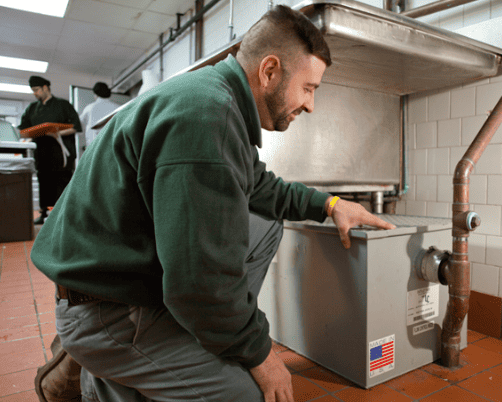
I get it. Owning and operating a restaurant involves a million decisions, from picking the right menu items to hiring the perfect staff. But if there’s one decision you shouldn’t drag your feet on, it’s installing a grease trap.
For many Florida restaurants, this simple oversight can lead to many problems. And believe me, as someone who’s consulted across the Sunshine State, I’ve seen the fallout firsthand.
The Urgency for Restaurants Without a Grease Trap
Imagine this: It’s a sweltering summer day. Your restaurant is packed, the fryer’s going non-stop, and life is good.
But then, without warning, there’s a backflow in your sinks, a foul smell fills the kitchen, and your entire operation grinds to a halt. This, my friends, is the reality for many establishments that still need to prioritize a grease trap installation.
Without one, you’re sending all that FOG (fats, oils, and grease) straight into the drainage system. Over time, this builds up, leading to blockages and severe plumbing issues.
Not to mention the potential for hefty fines if local authorities discover you’re contributing to sewer system problems. The cost, both financially and reputationally, can be devastating.
Personal Stories of Restaurants That Faced Issues by Delaying Installation
I’ll never forget this charming little eatery in Key West.
Let’s call it “Maggie’s”. Maggie, the owner, had been in the restaurant business for decades but had continuously operated without a grease trap.
She believed her establishment needed to be bigger to cause any significant issues. But one fateful day, there was a significant backup, and the restaurant had to shut down for a week.
The plumbing costs alone were excessive, but the lost business and damage to her reputation hurt even more.
Then there was “The Seaside Grill” in Panama City. They were relatively new and had a booming business. Still, they pushed off the grease trap installation to save on initial costs.
This decision came back to haunt them when, during peak tourist season, they faced a drainage issue and a fine from the city for not complying with local regulations.
The moral of these stories?
Investing in a grease trap is a wise choice that shouldn’t be overlooked or delayed.
The upfront cost may seem insignificant compared to the potential expenses in the future. Take proactive measures now to avoid unforeseen expenses later on.
In a business where word of mouth is everything, you don’t want to be known as “that place with the plumbing issues.”
To all my fellow restaurateurs in Florida and beyond, stay ahead of the game, protect your business, and ensure smooth operations by installing a grease trap sooner rather than later. It’s one decision you won’t regret.
Conclusion
Folks, if there’s one thing I hope you take away from all this, it’s the sheer importance of a grease trap in restaurants.
From my sunny corner here in Florida, having consulted with countless eateries, from the vibrant streets of Miami to the laid-back vibes of the Keys, I can’t emphasize enough how central a grease trap is to the sustainability and compliance of any dining establishment.
Restaurants are about more than just serving food. They’re about creating experiences.
And trust me; nothing ruins an experience faster than the foul smell of a clogged drain or the negative press of not adhering to local regulations.
Every restaurant, big or small, contributes to the overall health of our local sewer systems. And it’s our collective responsibility to ensure we aren’t harming our communities.
So, here’s my call to action to all the passionate restaurant owners, chefs, and operators: Don’t just install a grease trap.
Ensure it’s fit for your establishment and commit to its regular maintenance. It’s not just about avoiding those nasty fines or potential plumbing nightmares; it’s about contributing to a greener, cleaner Florida (wherever you may be).
It’s about ensuring that your restaurant runs as smoothly as possible, day in and day out.
Take it from someone who’s seen the highs and lows of the Florida restaurant scene – a grease trap might seem like just another piece of equipment.
Still, it’s the unsung hero of a smooth-operating kitchen. So, give it the attention it deserves, and your restaurant will thank you.
Here’s to clean drains, clear consciences, and the continued success of your dining establishments.
Cheers.
Jeff Smith is a Restaurant Consultant with over 20 years of hospitality experience ranging from server to owner and general manager. He focuses on Restaurant POS technology as well as restaurant marketing. Check out our world-famous restaurant resources page for a comprehensive offering of hand-picked resources and tools to help your business. You can also check out some of our other restaurant business articles.

